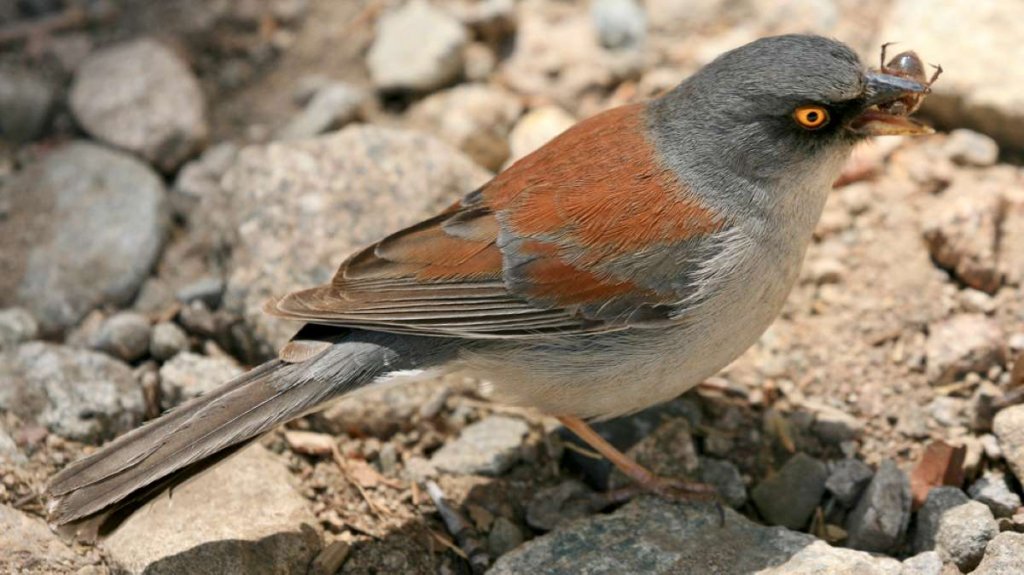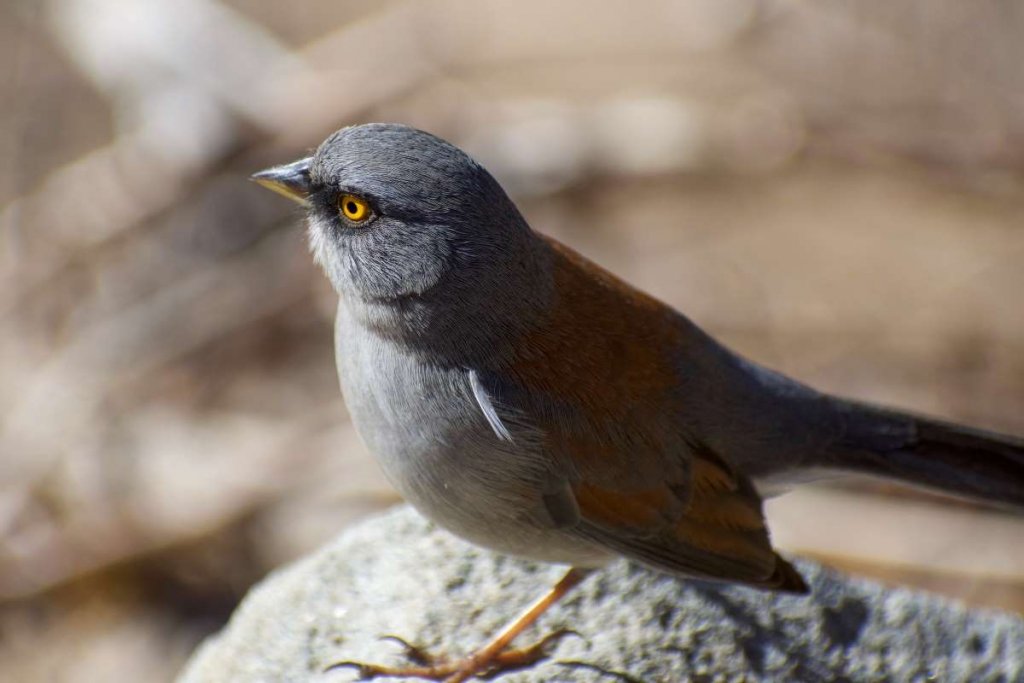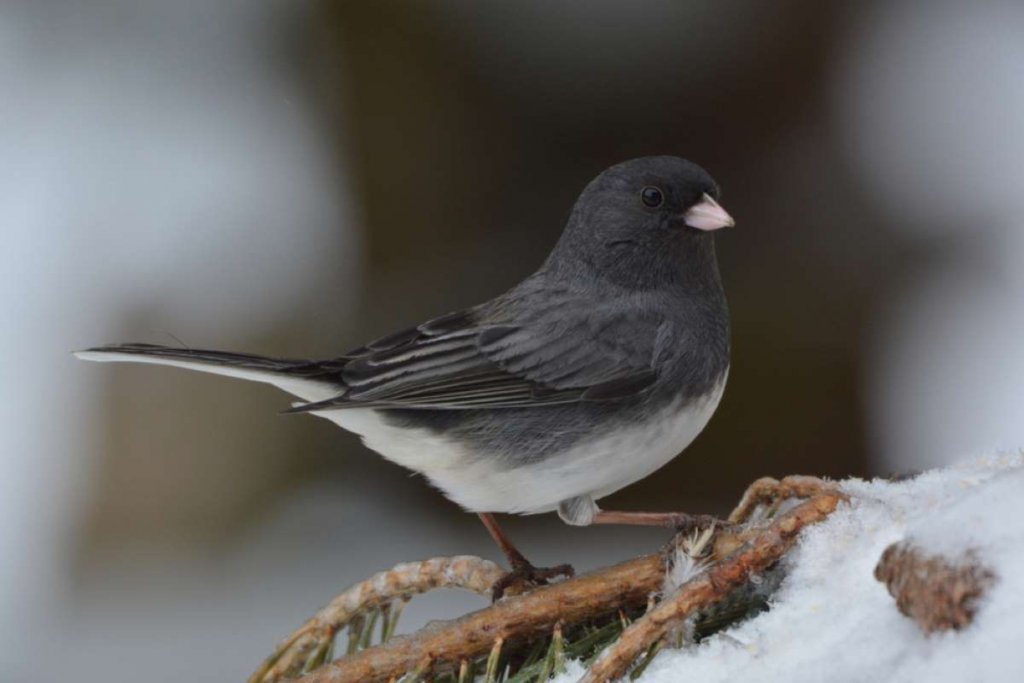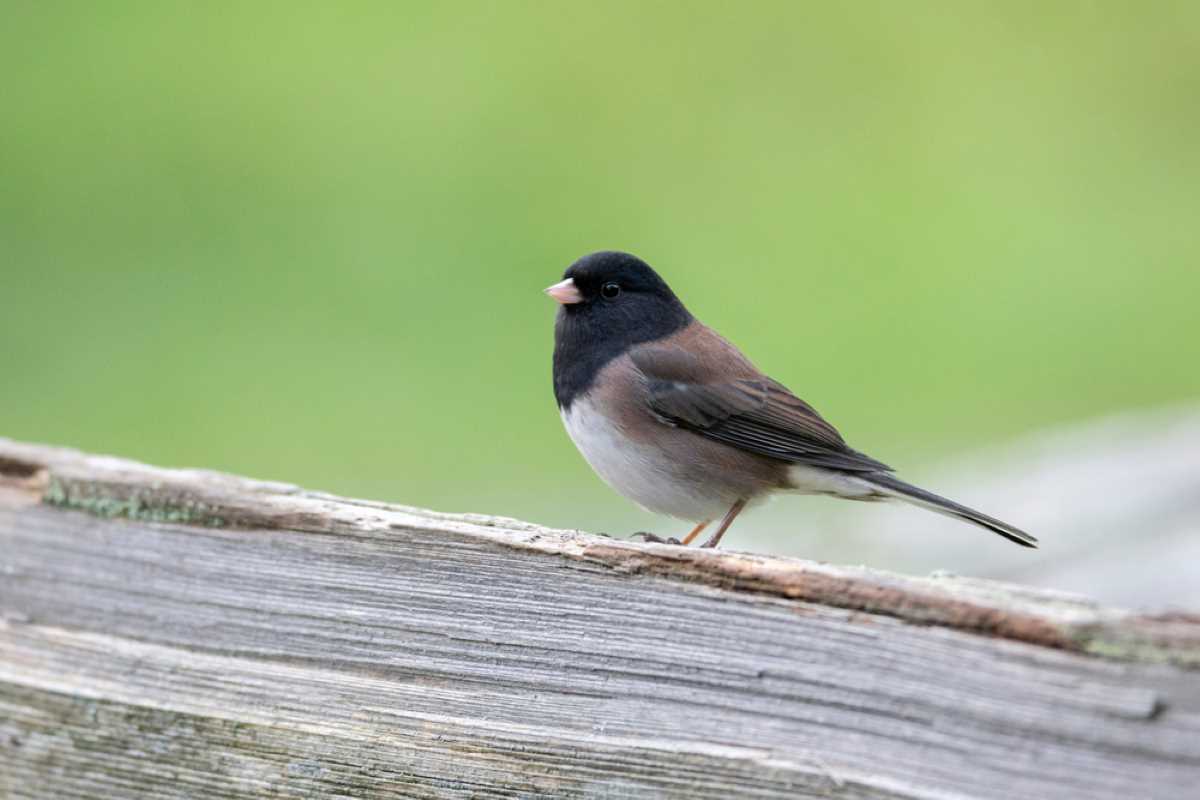Male Juncos produce a song with 7 to 23 notes in an even trill. Males can sing long-range songs or short-range songs, each serving a different purpose. Both sexes produce a call of ‘ticks’ to communicate with each other.
The Dark-eyed Junco song is a musical, even trill of between 7 and 23 notes. This song lasts about two seconds and is loud enough to hear from several hundred feet away. Male juncos sing more commonly than females.
Quick Facts about Juncos
- Belong to the family of New World Sparrows
- Scientific name is Junco hyemalis
- Juncos are migratory songbirds
- Bird watchers believe there are about 630 million Juncos in North America
- Juncos are between 5.25-6 inches in length
- They have a small pink bill
- They have white outer tail feathers, which are very visible while they fly
Subspecies of Juncos
Scientists once thought that each subspecies of Junco was a different type of bird. They have since discovered that although Juncos differ widely in color depending on the region, they are all related. There are two different types of Juncos:
- Yellow-eyed Juncos
- Dark-eyed Juncos
The Yellow-eyed Junco stays mainly in Mexico, Arizona, and New Mexico. Most Yellow-eyed Juncos don’t migrate. This type of Junco walks on the ground and has a more varied song than the Dark-eyed Junco. The Dark-eyed Junco can be divided into at least 7 variants, including:
- Cassiar Junco
- Gray-headed Junco
- Oregon Junco
- Pink-sided Junco
- Red-backed Junco
- Slate-colored Junco
- White-winged Junco
The Gray-headed Junco is the most common variety east of the Rocky Mountains and in Alaska. In the west, Juncos come in a variety of colors. Dark-eyed Juncos hop on the ground instead of walking. The most common western types are the Oregon Junco, the Slate-colored Junco, and the Gray-headed Junco.

Dark-eyed Junco Bird Sounds
Dark-eyed Juncos make two types of sounds: songs and calls. Each sound has a different purpose. Calls are simple vocalizations that birds use to communicate with each other. They are usually instinctual.
Songs, on the other hand, are longer and more complex. Songs are learned and can take on characteristics of other backyard birds. Songs also play an important role in courtship and mating.
The Dark-eyed Junco Song
Songs can be divided into two categories:
- Long-range sounds (LRS)
- Short-range sounds (SRS)
The LRS consists of a musical, even trill of between 7 and 23 notes. It lasts for two seconds on average. This song sounds similar to that of a Chipping Sparrow, Towhee, or Pine Warbler. The LRS is loud enough to hear from hundreds of feet away and is considered the mating call of the Junco. After his song, the male Junco waits between 4 and 11 seconds before singing again. Males have between 2 and 5 different LRS.
The SRS is entirely different and resembles the American Goldfinch’s song. Each note is different, and the song sounds much more complex. Juncos can produce between 6 and 40 different syllables during short songs. The SRS can be heard from around 40 feet away. Juncos also sing these quiet birdsongs during courtship.
What is a Junco’s Call?
The Dark-eyed Junco’s call consists of a high note given in rapid succession. These ‘ticks’ or ‘tiitii’ calls are more often used as Juncos forage or fly. Bird calls that sound like a ‘tsick’ or a ‘tchet’ are used to keep track of flock members or warn of danger nearby.
Males are territorial during the summer nesting season. They use calls to enforce territories or ward off intruders. Ornithologists report that a Junco makes as many as seven different calls.

How Do The Dark-eyed Juncos Migrate?
Juncos range through most of North America. They migrate north between March and June. Juncos inhabit Alaska and most of Canada during the spring and summer. Juncos breed mainly in Canada. Males and females raise young together before migrating south for the winter.
Juncos migrate south between September and November. These birds make their winter homes in much of the United States. They are prevalent at backyard feeders and in parks and forests. Juncos stay year-round in some areas of Arizona, California, Oregon, Colorado, western Canada, and many east coast states.
During the winter, Juncos live in flocks. A flock of Juncos has many names, including:
- Crew
- Host
- Fluttering
- Chittering
Flocks contain between 6 and 30 birds. Juncos commonly join other flocks of Chickadees, Kinglets, or Sparrows. A Junco flock has a strict hierarchy: adult males rank highest, followed by juvenile males, then adult females, and finally juvenile females. Birds who arrive first tend to rank higher than those who arrive later.
Why Are Dark-eyed Juncos Called Snowbirds?
Dark-eyed Juncos are called snowbirds because they migrate south near the time snow falls. Sometimes they are even thought to bring the snow with them. Juncos are commonly seen at North American feeders in the winter. They often dig in and peck at the snow, like the Fox Sparrow, to find food underneath.
Another reason they are called snowbirds is because of their coloring. Generally, Juncos have a dark back or top feathers and a white belly. This coloring pattern signifies snow on the ground, while the dark upper feathers signify winter’s ‘gray skies’. Winter is the best time to observe Juncos. They feed from bird feeders in cold weather and even blizzards.

Nesting Habits of Juncos
Adult males typically stay farther north during the winter to arrive at summer breeding grounds more quickly. Once they arrive in Canada, they choose territories. Females begin building nests soon after they migrate north. Females fly farther south during winter since they don’t compete for territory like the males do each spring.
Junco nests are usually built at ground level. They are surrounded by rocks or built into a slight depression in the earth. Female Juncos build their nests out of twigs, grasses, leaves, or roots. She lines her nest with pine needles, moss, grasses, feathers, or hair. Nests area actually shaped like an open cup and generally measure 3.5 inches across.
How Juncos Breed And Raise Young
Juncos prefer to breed in coniferous forests of pine, spruce, or fir trees. They may also use deciduous forests of aspen, cottonwood, or maple trees. Both males and females work to feed Junco nestlings. During their breeding season, Juncos expand their diet to include insects such as beetles, moths, caterpillars, ants, and wasps.
Females typically lay between 3 and about 5 eggs at a time. Female Juncos can have two broods per year, though some females may have as many as three. Junco eggs must be incubated 11-13 before they hatch. Junco young leave the nest 9-13 days after hatching and begin to forage on their own. Males and females remain monogamous for each breeding season but often choose new mates each year.

